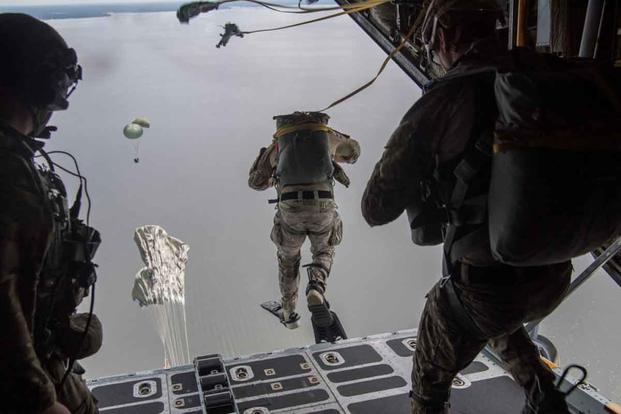Two women -- an enlisted member and an officer -- are currently tackling special warfare training courses within the Air Force's rigorous combat training pipeline, according to the service.
In July, Military.com reported that a single female Special Tactics Officer, or STO, candidate had advanced the farthest in that specialty; she is still on track in her training, according to 1st Lt. Alejandra Fontalvo, spokeswoman for Air Force Special Tactics with the 24th Special Operations Wing at Hurlburt Field, Florida.
Fontalvo could not disclose further details, including the name of the candidate, for privacy reasons. Previously, she said the same candidate had completed the "STO Phase 2 Assessment" conducted by Air Force Special Operations Command (AFSOC), as well as the Special Tactics/Guardian Angel Assessment and Selection Course.
Read Next: How the Air Force Will Expand Its Pacific Island-Hopping Campaign in 2021
Additionally, "a new female U.S. Air Force Academy cadet was selected out of our rigorous one-week assessment and selection to enter the two-year STO pipeline following graduation," the spokeswoman said in a statement Tuesday.
An enlisted trainee who began the Tactical Air Control Party Apprentice Course over the summer is still in the program, which is set to resume next month, said Capt. Kayshel Trudell, spokeswoman for Air Education and Training Command at Joint Base San Antonio-Lackland, Texas.
Another enlisted woman who began the Special Warfare Preparatory Course -- an eight-week program that follows Basic Military Training -- has removed herself from training and is awaiting career reclassification, Trudell said.
A removal "can encompass several reasons, ranging from self-elimination, medical disqualification, injury, or administrative [elimination]," she said in an email.
The COVID-19 pandemic has not been a factor for the women awaiting their training, Trudell added.
Two women who had been attempting to enter the service's combat controller and pararescue career fields since fall 2019 reclassified into other jobs over the summer; they were not selected to continue in the next phase, known as the Assessment and Selection (A&S) course, AETC said at the time.
It was not the first time women have advanced to the A&S level and were subsequently withdrawn. One Pararescue candidate and a Special Operations Weather Technician candidate -- the field has since been reclassified as Special Reconnaissance -- entered the A&S course last year, but neither successfully completed the program.
Since the Defense Department opened combat career fields to women in December 2015, few female airmen have qualified for Air Force special warfare training.
Special warfare career fields include special tactics officer, combat rescue officer, combat controller, pararescue, special reconnaissance, Tactical Air Control Party specialist and Tactical Air Control Party Officer, formerly known as air liaison officers.
Some female candidates have self-eliminated or sustained injuries; others have not met the standards of a particular program.
But the Air Force's top officer doesn't want women to be discouraged from pursuing the battlefield curriculum.
Air Force Chief of Staff Gen. Charles "CQ" Brown said the service has been on a path to prep any airman interested in special warfare with the proper physical conditioning, education, development and mentorship needed for the role.
"We want to make sure everyone has an opportunity," Brown said in an interview with Military.com last week. "We're looking at kind of the full spectrum of human performance and how it considers gender, medical and social history to use that data to help improve health performance. In some cases, it can't always be a 'one size fits all' … and we want to ensure women have an equal opportunity."
Standards, however, will not change -- just the tools to get them there, Brown stressed.
"The attrition rate is pretty high, whether you're male or female, just based on the physical demands. It takes a special person who actually has that skill set to get through," he said.
In 2019, Lt. Gen. Brian Kelly, the Air Force's deputy chief of staff for manpower, personnel and services, said in written testimony before the Senate Armed Services subcommittee on personnel that attrition in these career field pipelines has been high because of the grueling training. Attrition across the elite training pipelines ranges between 40% and 90%, depending on specialty, he said at the time.
"My goal, just like any other career field, is to ensure that those that have the desire have the aptitude. We want to make them successful and get them through the training program," Brown said.
In February, the service announced it had created a new single-entry program for recruits interested in these career fields to identify candidates with the aptitude and skills to become special warfare airmen earlier. Selected special warfare candidates within Basic Military Training began entering Air Education and Training Command's new Special Warfare Operator Enlistment Vectoring program in April. SWOE-V gives airmen some leeway instead of immediately assigning them to specialties before they can make a competent decision about their career choice.
"We don't want to put an airman in a position that is not set up for success," Brown said.
-- Oriana Pawlyk can be reached at oriana.pawlyk@military.com. Follow her on Twitter at @Oriana0214.
Related: Air Force Special Operators Get New Specialty Code Amid Field Consolidation













